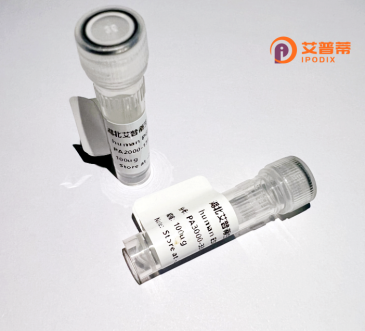
| 纯度 | >90%SDS-PAGE. |
| 种属 | Human |
| 靶点 | UBE2Q |
| Uniprot No | Q7Z7E8 |
| 内毒素 | < 0.01EU/μg |
| 表达宿主 | E.coli |
| 表达区间 | 1-422 aa |
| 活性数据 | MQQPQPQGQQ QPGPGQQLGG QGAAPGAGGG PGGGPGPGPC LRRELKLLES IFHRGHERFR IASACLDELS CEFLLAGAGG AGAGAAPGPH LPPRGSVPGD PVRIHCNITE SYPAVPPIWS VESDDPNLAA VLERLVDIKK GNTLLLQHLK RIISDLCKLY NLPQHPDVEM LDQPLPAEQC TQEDVSSEDE DEEMPEDTED LDHYEMKEEE PAEGKKSEDD GIGKENLAIL EKIKKNQRQD YLNGAVSGSV QATDRLMKEL RDIYRSQSFK GGNYAVELVN DSLYDWNVKL LKVDQDSALH NDLQILKEKE GADFILLNFS FKDNFPFDPP FVRVVSPVLS GGYVLGGGAI CMELLTKQGW SSAYSIESVI MQISATLVKG KARVQFGANK SQYSLTRAQQ SYKSLVQIHE KNGWYTPPKE DG |
| 分子量 | 46.1 kDa |
| 蛋白标签 | His tag N-Terminus |
| 缓冲液 | PBS, pH7.4, containing 0.01% SKL, 1mM DTT, 5% Trehalose and Proclin300. |
| 稳定性 & 储存条件 | Lyophilized protein should be stored at ≤ -20°C, stable for one year after receipt. Reconstituted protein solution can be stored at 2-8°C for 2-7 days. Aliquots of reconstituted samples are stable at ≤ -20°C for 3 months. |
| 复溶 | Always centrifuge tubes before opening.Do not mix by vortex or pipetting. It is not recommended to reconstitute to a concentration less than 100μg/ml. Dissolve the lyophilized protein in distilled water. Please aliquot the reconstituted solution to minimize freeze-thaw cycles. |
以下是关于重组人UBE2Q蛋白的3篇文献及其摘要概括:
---
1. **文献名称**:*Structural Insights into UBE2Q1. a Putative Ubiquitin-Conjugating Enzyme*
**作者**:Yadav, S.S., Mandal, P.K.
**摘要**:通过X射线晶体学解析UBE2Q1的三维结构,揭示其催化活性域和潜在的底物结合位点,为研究其在泛素化信号通路中的功能提供结构基础。
2. **文献名称**:*UBE2Q1 Overexpression Promotes Tumor Progression in Hepatocellular Carcinoma*
**作者**:Chen, L., et al.
**摘要**:研究表明UBE2Q1在肝癌组织中显著高表达,通过调控细胞周期和凋亡相关蛋白的泛素化促进肿瘤生长,提示其作为肝癌治疗靶点的潜力。
3. **文献名称**:*In Vitro Reconstitution of UBE2Q1-Mediated Ubiquitination*
**作者**:Kumar, R., et al.
**摘要**:构建体外泛素化实验体系,证明重组UBE2Q1蛋白具有泛素转移酶活性,并鉴定其与特定E3连接酶的协同作用,为研究泛素化机制提供方法学支持。
---
**备注**:文献涉及UBE2Q1(UBE2Q家族成员之一),研究领域涵盖结构生物学、癌症机制及酶学方法。如需扩展,建议检索PubMed或Web of Science获取更新进展。
Ubiquitin-conjugating enzyme E2 Q (UBE2Q) is a member of the E2 ubiquitin-conjugating enzyme family, which plays a critical role in the ubiquitin-proteasome system (UPS). The UPS regulates protein degradation, a tightly controlled process essential for maintaining cellular homeostasis, cell cycle progression, DNA repair, and signal transduction. UBE2Q enzymes are responsible for transferring ubiquitin from E1 ubiquitin-activating enzymes to specific substrate proteins, typically in collaboration with E3 ubiquitin ligases. This ubiquitination marks target proteins for proteasomal degradation or modulates their activity, localization, or interactions. UBE2Q1. a well-characterized isoform, contains a conserved catalytic core domain (UBC) critical for its enzymatic function.
Although less studied compared to other E2 enzymes, UBE2Q has been implicated in diverse physiological and pathological processes. Emerging evidence links UBE2Q to cancer progression, neurodevelopmental disorders, and immune regulation. For example, it may influence tumor cell proliferation, apoptosis, and drug resistance by modulating key oncoproteins or tumor suppressors. However, its precise molecular mechanisms, substrate specificity, and regulatory networks remain largely unresolved.
Recombinant human UBE2Q proteins are generated via heterologous expression systems (e.g., E. coli or mammalian cells) for functional studies. These tools enable biochemical assays, structural analysis, and exploration of interactions with E3 ligases or substrates. Research on UBE2Q could advance therapeutic strategies targeting ubiquitination pathways in diseases like cancer or neurodegeneration.
×